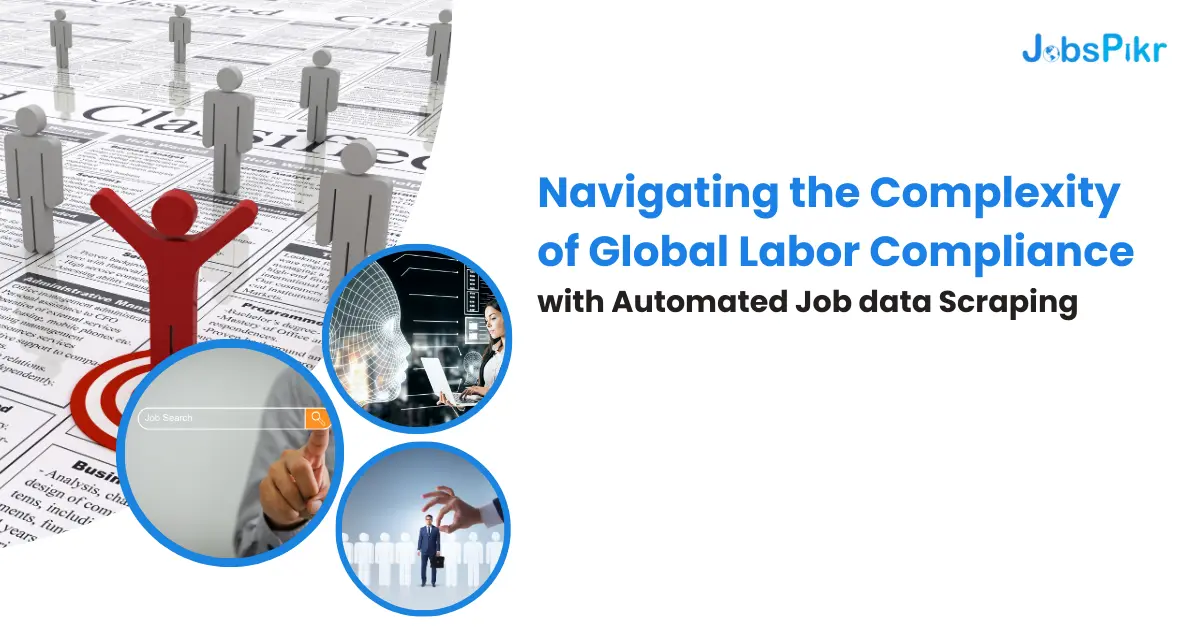Digital Transformation and Global Expansion are among the top 5 goals of every ambitious business owner today. Both of these however require companies to be compliant with the digital and labor laws and regulations of different countries. Noncompliance and misses not only lead to reputational loss but also financial loss in the form of massive fines and lawsuits. The vast amount of job data available online spread across different sectors and continents can be mined and filtered to figure out easy ways to stay compliant with the latest laws.
Applying job data scraping to crack compliance
Having a ton of job data at your hand wouldn’t automatically make you compliant with the latest laws. Hence, even before you begin your journey to scrape job data, extract certain data points, and generate information that may not be visible in the raw data, you need to figure out what your real goal is.
Identifying relevant labor laws and regulations
Job postings, employee benefits, working conditions, remote options, overtime pay, working hours, safety standards, tax saving plans– based on the country or region in focus, there may be a lot to sift through. Hence it would be best to create a list and get it checked by a legal expert so that you know which topics you need more clarity on. Laws like CCPA or GDPR may seem complex at first, but as you see more examples of how companies are tackling it, you may be able to find simpler methods to stay on the right side of the law.
Monitoring and adopting compensation practices
This can be broken into 3 major parts:
- Salary structure– There are many laws governing the basic salary that is paid to employees. This can be regarding the minimum salary for certain kinds of jobs, the latest by when the salary for a month has to be paid, how it is paid, rules regarding variable portions of the salary, and more. Companies may also need to break down the entire salary into multiple sections and provide tax benefits on particular sections such as house rent or education loans.
- Added benefits– These can be of two types- compulsory benefits and optional benefits. For instance, some countries require companies to invest in some sort of retirement fund for their employees. Others require companies to provide mandatory medical insurance to all employees. Apart from the mandatory benefits, companies may also want to check the “usually expected” benefits in a country before they decide on the benefit structure for their employees.
- Overtime Pay– While some countries like India do not have any overtime pay for white and blue-collar employees, others like the US have strict overtime laws and noncompliance has led to some of the biggest corporate payouts. As a company, you may need to set different overtime rates and rules in different countries to abide by local laws.
Scraped and cleaned job data can easily help you in all three points mentioned above. You can even come up on top of laws and lay down a benefit structure that directly rewards employees who enable the company to function more efficiently and improve its bottom line.
Creating a safe work environment to protect employee rights
Different countries have come up with a multitude of laws to protect their employees from being exploited. These laws tackle issues like maternity/paternity leaves, glass ceilings, vacation days and mandatory time offs, as well as procedures to address grievances.
For instance, every country has rules concerning the minimum number of days an employee should be allowed to take off in a year. There are also laws regarding how and when an employee can be terminated and what benefits must be provided to him or her at that point. Maternity laws are quite thorough in most countries today such that women do not feel less equipped to handle their jobs and live up to their responsibilities.
Regularly monitoring job posts along with the latest news from the job market can help you be more aware of the laws of the land and ensure you are creating a work environment as close to what is recommended in the country.
Providing equal employment opportunities
Equal Employment Opportunity not only prescribes that you cannot discriminate between applicants based on race, ethnicity, gender, and sexual preference but also that their growth trajectories within the company must be unhindered by these factors. The latest instance of Amazon being sued by 3 employees for gender discrimination and pay parity highlights how important it is for companies to always view everyone with the same lens.
You need to ensure everyone interviewing at your company has an equal opportunity to get chosen, those at your company handling similar responsibilities are paid within the same range and no other factor other than one’s competence is relied upon when promoting them to senior positions.
Scraping more job data can help you understand how companies are trying to reach their diversity and inclusivity goals as well as the corporate standards that are followed as “unwritten rules”.
Automated compliance and reporting
Manual monitoring of labor law compliance can be time and resource-consuming and also lead to errors due to inherent bias. Instead automated data-based compliance tracking and reporting can save you both time and money. All three steps- data collection, aggregation, and reporting can be completed automatically by comparing the data that you collect internally from your employees against the intelligence gained by scraping tons of job data from the internet.
Adhering to data storage and access regulations
While scraping job data and using it to be compliant with the labor laws of each country, you will need to ensure that you are also compliant with data protection laws (such as CCPA and GDPR). These laws govern how data is stored, used, and deleted (when requested). These laws would not just govern the data that you scrape but also employee data that you may store in your systems.
Scraping Job Data
How well you can adhere to the global labor laws will depend on how good your data sources are and how regularly you can capture new industry trends and changes. Scraping job data from hundreds or thousands of websites across regions and sectors is no easy feat. Complex websites that generate content dynamically have made the challenge infinitely more difficult. For a standalone company to build a job scraping system just to support their legal team would neither be feasible nor get a signoff from the board.
The more logical way of going about things would be to use a cloud-based on-demand solution that is already trusted by industry veterans and Fortune 500 companies. This is where our DaaS solution JobsPikr comes in. Using JobsPikr you only pay for the data you need. So if you filter out job data and pick only a few countries and a few sectors, you will only be paying for job posts that you receive after those filters are applied.
With JobsPikr you can choose to use the raw data by processing it, normalizing it, and consuming it in-house, or you can even use the ready-to-use dashboards for salary benchmarking or labor market trend analysis.
Want to know how we can help you? Sign up for a free trial today.




